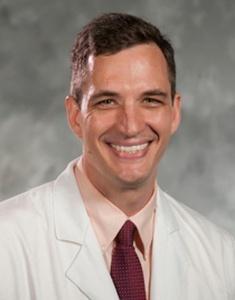
Rare, fusion-positive rhabdomyosarcoma is one of the most difficult childhood cancers to treat. In fact, more than 40 years of research hasn’t produced any significant treatment breakthroughs for this highly aggressive cancer, which can emerge almost anywhere in the body and typically strikes during the teen years.
Michael Deel, MD, assistant professor of pediatrics in the Division of Hematology-Oncology and member of the Duke Cancer Institute, has dedicated his career to studying this fusion-positive rhabdomyosarcoma, with a goal of giving patients a better shot at a long and healthy life.
“The initial treatment these patients receive today is the same as it was in the 1970s,” Deel said. “I hope that what we’re learning now will lead to a novel way of treating fusion-positive rhabdomyosarcoma that could be used as an add-on to current treatments.”
A difficult target
Fusion-positive rhabdomyosarcoma has confounded researchers for years because of what drives it. The cancer is caused by a protein called PAX3-FOXO1 that forms when pieces of two separate chromosomes become stuck together. When this happens, cells produce one giant, abnormal protein instead of two separate, healthy proteins.
“PAX3-FOXO1 is exclusively expressed in fusion-gene positive rhabdomyosarcoma, making it an ideal drug target,” said Deel. “However, it is a big, large disordered protein without any good drug binding sites. The research community has tried for decades to target it directly and has been unsuccessful.”
The PAX3-FOXO1 fusion protein is problematic because it binds to DNA and recruits gene expression machinery that turns on cancer-promoting genes. Since efforts to target the fusion protein directly have failed, Deel wants to find ways to inactivate the proteins that PAX3-FOXO1 needs to function.
Deel and his colleagues have identified the proteins YAP and TAZ as important activators for PAX3-FOXO1. With V Foundation funding, the researchers showed blocking the expression of these proteins in rhabdomyosarcoma cells also reduces expression of the cancer-promoting genes typically turned on by the fusion protein. They are now working to understand how this process occurs.
Studying cancer in 3D
Deel is also working to understand why fusion-positive rhabdomyosarcoma patients almost always respond to chemotherapy initially but then become resistant. “Even when there is extensive disease, we often see a dramatic response to a few cycles of chemotherapy,” said Deel. “However, the tumors will inevitably come back or become insensitive to chemotherapy.”
This led Deel to suspect that some cancer cells might act like stem cells, allowing them to reproduce and maintain the cancer after the chemo-sensitive cancer cells are killed. To follow this thread, Deel and his colleagues figured out how to grow fusion-positive rhabdomyosarcoma cells in a 3D culturing system, a useful platform for studying stem cell-like behaviors.
“This hypothesis was based on a cancer theory that tumors contain cells that can self renew like stem cells and are resistant to chemotherapy,” said Deel. “Although stem cell properties can be enriched by growing cancer cells in 3D spheres, this hasn’t previously been done for fusion-gene positive rhabdomyosarcoma.”
The team used the 3D culturing system to show that genetically inactivating YAP and TAZ expression reduced expression of stem cell genes and prevented the cells from growing in 3D spheres. The system can now be used to test compounds designed to treat fusion-positive rhabdomyosarcoma by inhibiting YAP and TAZ.
Looking for inhibitors
The researchers are now performing pre-clinical testing of YAP and TAZ pathway inhibitors developed by Vivace Therapeutics, a start-up company with which they are collaborating. The YAP-TAZ pathway has recently been shown to be important and highly prevalent in many other carcinomas, sparking an effort among pharmaceutical companies and academic researchers to develop new inhibitors for this pathway. Because of this research interest, Deel said he thinks YAP and TAZ inhibitors could make it to clinical trials in the next two to five years.
“The V Foundation funding was instrumental in helping me transition from a clinical fellow into an independent investigator role,” said Deel. “The preliminary data generated also helped me to secure additional funding to continue this line of research.”
This article was originally published on the V Foundation blog.
Related content
Faculty Spotlight: Michael D. Deel, MD
[02.08.2019]